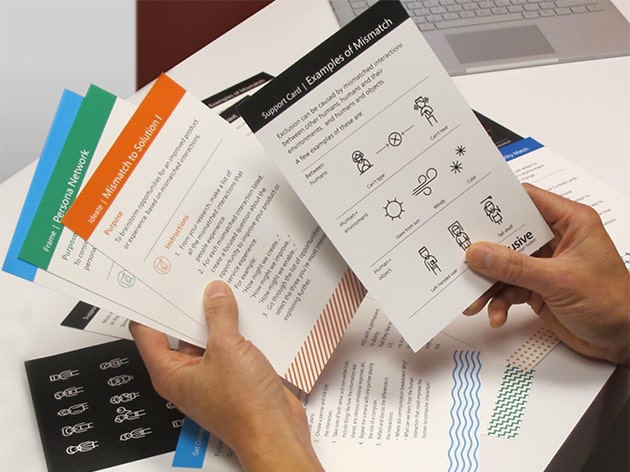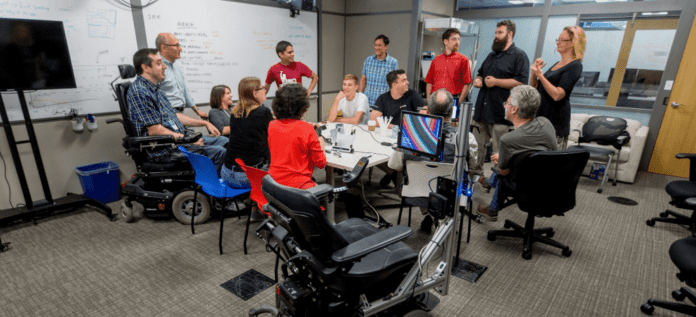Most consumers correlate the Microsoft Corporation with software products like Windows, the operating system that’s likely on your computer. The majority of users don’t realize that the company adopted a new mission to “empower every person and every organization on the planet to achieve more.” More specifically, Microsoft is leading the way to do more in our overall culture through “inclusive design” by embracing diversity and disability to further innovation.
According to the World Health Organization, ‘disability is a complex phenomenon reflecting the interaction between features of a person’s body and features of the society in which he/she lives. Overcoming the difficulties faced by people with disabilities requires interventions to remove environmental and social barriers.’ About three years ago, Microsoft shifted its focus to such interventions with the development of the Inclusive Design Toolkit. “Microsoft has a history of focusing on inclusion in many ways. I was hired to help create the Inclusive Design practice to help change how we make and, as a by-product, what we make. Inclusive Design helps provide access and equity, reduce friction and provide a net-positive emotional experience for the greatest number of people,” Margaret Price, Microsoft’s Principal Design Strategist, tells AmeriDisability Services. Free to download, the toolkit consists of a manual, activities and videos featuring experts of varying abilities offering design process insight. The toolkit is used by individuals, companies and universities around the world, and Microsoft’s Design Strategists have also directly influenced more than 6,000 users attending Inclusive Design workshops.
Demand for Technology
“Designing for people with permanent disabilities can seem like a significant constraint, but the resulting designs can actually benefit a much larger number of people,” says Price of designs that ‘scale.’ She explains that, for example, if a design is made for people with one arm, the product also benefits those with a temporary wrist injury or parents cradling an infant. “We call this the persona spectrum. Learning from a common, shared motivation and designing for range of situations,” she says, explaining that the spectrum is used for (1) building scenarios and (2) building a business case for why it’s important. “If you think about the number of people who have one arm in the U.S., that’s about 12,000 people but, if you add up the number of people who have one arm, have a temporary wrist injury and who have an infant, you have about 20 million,” Price calculates.
Three Principals of Inclusive Design
Microsoft declares that “there’s no such thing as an average human being. All humans are growing, changing and adapting to the world around them every day. With Inclusive Design, we can create experiences that embrace and reflect that diversity.” In a YouTube presentation, Price explained Microsoft’s three principals for Inclusive Design:
1) Recognizing Exclusion: “We design with our own abilities, our own preferences, our own circumstances as a baseline and, when we do that, the people who can benefit from our designs are those with equal or greater ability. So, if you think about me as an example, I am right-handed, [speak] English as a first language and I’m pretty tech-savvy. If I design with those as a baseline, I am potentially excluding everyone that does not meet those same attributes from the design. What this also means is that, as experienced creators, we can often design exclusion into our experiences no matter how unintentional that may be.”
2) Learning from Diversity: Microsoft seeks input from designers and consumers of all abilities. “Once we can build empathy and learn from people who are completely different from us, we can use these constraints to build more innovative solutions because it’s people that are experts at adapting to situations around them.”
3) Solve for One, Extend to Many: “Identifying and understanding the mismatches of one, we can design extremely innovative solutions.” For example, closed-captioning was created for the deaf and hard of hearing and high contrast settings were created for the visually-impaired, but both of these inventions actually serve users for many reasons beyond the original intent.

Transforming Culture
Price believes design is a powerful, problem-solving force in contemporary culture. “Design helps us understand and experience the world in new ways. Specifically, I often work with interaction designers and look at the way people naturally interact in environments as a model for how to create human-to-machine interactions,” she says, because interactions with technology usually centers on connecting people to one another through that technology.
Microsoft’s focus on inclusion has proved effective for consumers at-large and the company’s own workplace. “The impact is demonstrated in a massive culture shift. Mindsets and behaviors have changed. As a result, what we make has changed, ”Price says. For example, Saquib Shaikh is a Microsoft engineer who is blind. He uses screen-reader technology to code just as proficiently and creatively as a sighted-person. Shaikh helped to create Seeing AI, Microsoft’s free app designed for the low-vision community. It narrates the world around you to describe people, text and objects. Also, with Team Gleason, Microsoft refined eye-tracking and wheelchair navigation to benefit people living with ALS, or Lou Gehrig’s disease. And last year, a study by the British Dyslexia Association found that Microsoft’s One Note digital notebook helped dyslexic children improve their reading and spelling skills. Regarding the scale affect, Price says One Note’s technology has also helped people with Attention Deficit Hyperactivity Disorder (ADHD), those learning a second language and others with intellectual disabilities.
Price personally has ADHD and shared, “One of the reasons I work at Microsoft is to help build technology that’ll be used by people like me, who are deeply bothered by interruptions. Beyond a momentary disruption, interruptions like visual pop ups, sound, email calendar reminders, lights, etc. can be extremely distressing when trying to achieve sustained concentration. I love using the ‘do not disturb’ on my iPhone when working on the go because I can trust that my focus will remain on the task, not the tool.” Additionally, Xbox, a Microsoft brand, spearheaded an initiative to enhance social gaming for deaf and hard-of-hearing players. Some outcomes from the effort involved new inclusion of emojis on the virtual keyboard to allow deaf users to better convey and understand emotion, and the creation of the Deaf Gamers Collection which is just one example of an Xbox ‘club.’ Participants in this Xbox design series found that inclusive designs would, indeed, scale beyond the deaf community. “Accessibility is not the goal of inclusive design but, rather, observing how people of different levels of ability navigate a typical situation and use that analog as a starting point for design features,” shared August de Los Reyes, Design Director for Xbox.






